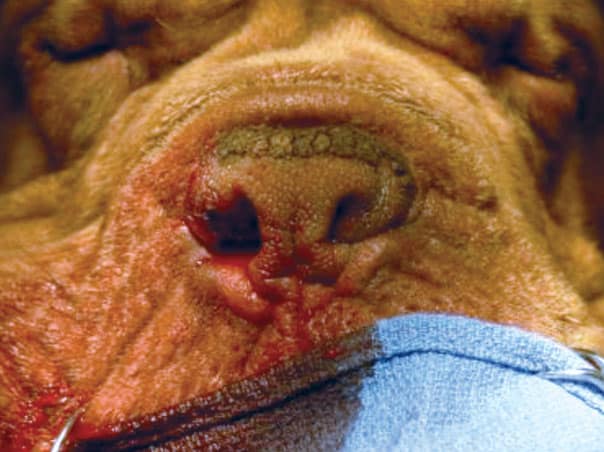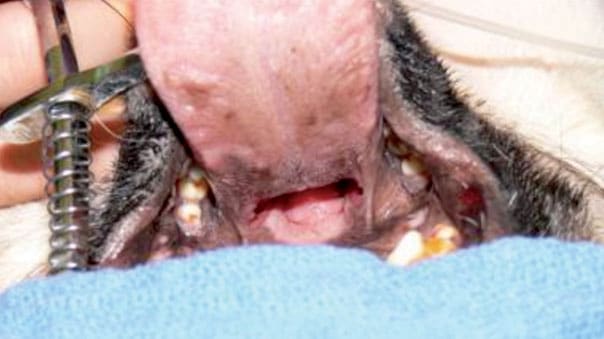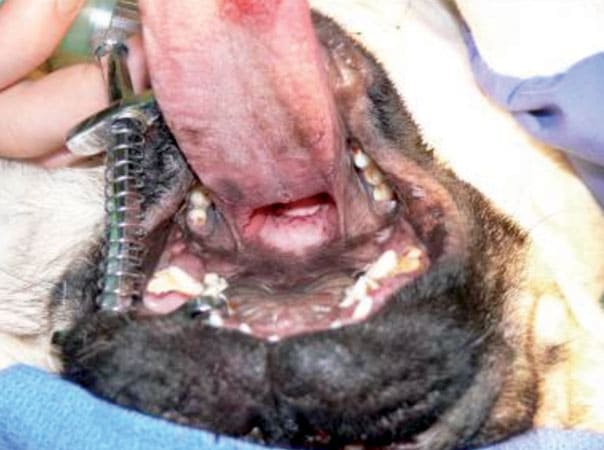
What does brachycephalic mean?
The term brachycephalic comes from the Greek meaning ‘short’ and cephalic meaning ‘head’ i.e. brachycephalic animals are those with short heads.
What is Brachycephalic Obstructive Airway Syndrome (BOAS)?
Brachycephalic obstructive airway syndrome is the term given to the effects that the shortened head of these animals has on the passage of air through the upper airways. The signs can vary in severity from mild snoring or snorting noises to severe breathing problems.
Animals suffering from clinically significant BOAS can struggle to breathe during exercise and may suffer collapse due to lack of air. The reliance of dogs on panting to cool themselves also makes animals suffering from BOAS very susceptible to overheating and developing potentially very serious breathing difficulties in hot conditions.
What breeds are affected?
Brachycephalic breeds include those breeds of dog and cat that have an obvious, characteristic short or squashed nose appearance. Any breed of dog or cat with a brachycephalic head conformation can be affected, e.g.:
Dogs:
- English Bulldog
- French Bulldog
- Dogue de Bordeaux
- Boxer
- Pug
- Cavalier King Charles Spaniel
- Lhasa Apso
- Shih Tsu
- Pekingese
- Other brachycephalic breeds
Cats:
- Persian
- Himalayan
Why do these animals have problems?
There are four main areas of concern in these animals:
- Narrow nares (nostrils)
- Overlong palate
- Secondary effects such as collapse of the larynx (voice box)
- Tracheal hypoplasia (the trachea or windpipe is too small for the size of animal – almost exclusively encountered in the English Bulldog breed)
Whilst dogs are commonly presented to vets with clinically significant problems resulting from BOAS, cats are rarely presented for treatment. This may partly be a reflection of the more sedentary lifestyle of some cats compared to dogs; most cats that are presented only require treatment for narrowed nares (nostrils).
Narrowed nares (nostrils) can dramatically increase the resistance to air flow into the nose of brachycephalic breeds. This, combined with the tendency for the cartilage supports of the nares to collapse during inspiration, requires a much larger effort than normal in order to breathe.
An overlong soft palate can partially obstruct air flow into the trachea (windpipe) and also cause turbulent airflow in the area of the larynx (voicebox). Both of these effects further increase the effort required for an affected animal to breathe in, and can cause significant inflammation of the upper airway.
Unfortunately, the extra effort required to breathe in (inspiration) eventually results in secondary problems, since the airway is not adapted to cope with the turbulence and increased negative pressures which develop.
These secondary effects include:
- Gradual collapse of the larynx (voice-box) termed laryngeal collapse. Veterinary surgeons grade the severity of collapse from 1 to 3, with 3 being the most severe. Unfortunately, the collapse is likely to be progressive, although the rate of progression may be able to be slowed with appropriate treatment.
- Tonsillar eversion and hypertrophy. The tonsils usually lie in shallow recesses towards the back of the mouth. The increased negative pressures can cause them to enlarge and protrude into the back of the mouth, further narrowing the airway.
- Pharyngeal muscle hypertrophy. The pharynx is the term used to describe the area of the back of the mouth and entrance to the larynx. These muscles can become enlarged (hypertrophied) due to the altered pressures in the upper airway.
- Acid reflux from the stomach into the oesophagus (food pipe). This can result in inflammation of the oesophagus and sometimes in ulceration of the stomach. Severe cases may suffer from a hiatal hernia, when part of the stomach can become displaced into the chest cavity during breathing.
- Heart failure – this is less common than the other secondary effects of BOAS.
How is BOAS diagnosed?
When carrying out a physical examination, your primary care vet will assess your dog or cat’s anatomy (some heads are shorter than others) and your pet’s behaviour in certain circumstances.
Most brachycephalic animals will experience a degree of upper airway obstruction, usually evident as snorting or snoring noises. The key is for you and your veterinary surgeon to decide between you whether your pet is experiencing a significant level of signs or showing an anatomical conformation that may predispose him/her to problems. The discussion will involve how your pet copes with exercise or warm conditions and also any likely susceptibility to secondary deterioration within the airway.
Unfortunately, only the nares (nostrils) can be properly assessed without the requirement for a general anaesthetic. Initially therefore, the diagnosis is based on the veterinary surgeon’s overall assessment but will require further investigation to confirm the diagnosis.
How is BOAS investigated by the veterinary surgeon?
There are a number of tests that may be required, depending on the findings of the initial physical examination. These can include blood tests, cardiac (heart) assessment and chest X-rays. However, full airway assessment will require an anaesthetic.
General anaesthesia in brachycephalic dogs can be associated with increased risk, particularly during the induction and recovery phases.
Many primary care veterinary surgeons would choose to refer these cases to an experienced surgeon to carry out an assessment of the airway under general anaesthesia, with the advantage that surgical treatment can be carried out under the same anaesthetic and therefore reduce the risks during the recovery phase.
The surgeon may use an endoscope (small camera) to examine the oesophagus for signs of gastric reflux.
What treatment options are available?
Stenotic Nares (narrowed nostrils)
Removal of a section of the cartilage of the front of the nose or a section of skin next to the nose can improve the airflow through the nares.

A Dogue de Bordeaux following surgery on one side to improve the airflow through the nostril
Overlong Soft Palate
The excess length of the soft palate can be reduced by surgery in order to reduce the interference with air flow into the larynx (voice box).

Before surgery to shorten the soft palate

After surgery to shorten the soft palate
Laryngeal Collapse
Early laryngeal collapse can sometimes be improved by removal of some of the tissue that is slowing airflow. The surgeon will assess the larynx (voice box) and decide whether additional surgery in this area is appropriate or likely to be beneficial. Sometimes, this additional procedure may need to be carried out at a later date.
Severe (Grade 3) collapse is unlikely to benefit greatly from a minor procedure and may require a permanent tracheostomy (breathing hole in the neck), or can sometimes be temporarily improved with a tieback procedure (see laryngeal paralysis information sheet).
Everted tonsils
Some cases may benefit from tonsillectomy (removal of the tonsils). The decision on whether this is appropriate is made at the time of assessment and surgery.
Acid reflux
Treatment for gastric reflux usually involves regular medication, rather like one might take for heartburn.
Hiatal Hernia
In general, conservative management is initially employed in cases suffering from displacement of a section of the stomach into the chest, although some cases do require surgical treatment.
Weight management
The lifestyle of many of these patients can predisposed them to obesity. Weight loss can dramatically improve the airflow through the pharynx and neck and MUST form part of the treatment protocol in overweight patients.
What is the prognosis (outlook) for my dog or cat?
Most dogs suffering from clinical signs of BOAS that receive prompt appropriate treatment can experience a significant improvement in exercise tolerance and ease of breathing. However, due to the fact that the surgeon can never create a completely normal airway for brachycephalic animals, they remain susceptible to heat stress and many are unlikely to be able to exercise to a level that one might expect from animals with normal head conformation.
It is generally hoped that surgery to the nares, soft palate and the larynx will slow the progression of laryngeal collapse (voice box collapse) by improving the airflow and reducing the negative pressures developed during respiration. Early surgery, carried out before the laryngeal collapse has become severe, should maximise the benefit from surgery and minimise the risks of significant laryngeal collapse later in life.
Many dogs do not experience significant further deterioration in the larynx during their lifetime and therefore never require further surgery. Unfortunately, despite treatment, laryngeal collapse can reach a critical level in some cases and may require further surgery at some point in the future.
Despite the many precautions taken by veterinary surgeons in assessment and treatment of these patients, the risk of the general anaesthetic and surgery to the airway can never be eliminated. The surgeons and anaesthetists at North Downs Specialist Referrals are acutely aware of the special needs of brachycephalic patients undergoing general anaesthesia and airway surgery.
Hypoplastic trachea (small windpipe) cannot be treated and these dogs are often severely affected by the impairment to airflow associated with this condition.
If you have any queries or concerns, please do not hesitate to contact us.
Arranging a referral for your pet
If you would like to refer your pet to see one of our Specialists please visit our Arranging a Referral page.